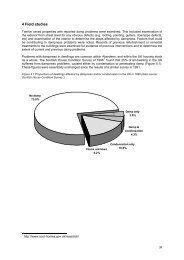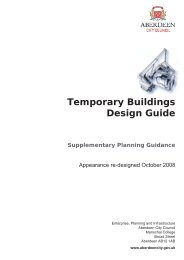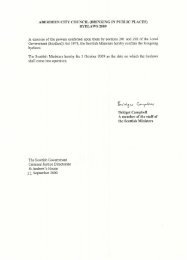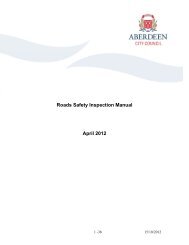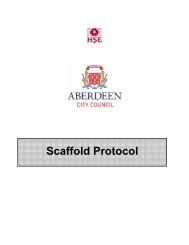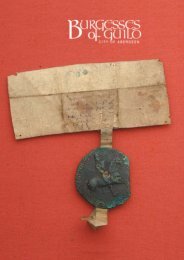Tullos Hill - A Guide - Aberdeen City Council
Tullos Hill - A Guide - Aberdeen City Council
Tullos Hill - A Guide - Aberdeen City Council
- No tags were found...
You also want an ePaper? Increase the reach of your titles
YUMPU automatically turns print PDFs into web optimized ePapers that Google loves.
6<strong>Tullos</strong> CairnAround 200 historic andarchaeological features have beenidentified on <strong>Tullos</strong> <strong>Hill</strong>. Listed hereand shown on Map 1 is a selection ofmore visible features and groups.1Crab’s CairnThis is the least visible and robust of thelong-identified group of Bronze Age burialcairns on <strong>Tullos</strong> <strong>Hill</strong>, which also includes<strong>Tullos</strong> Cairn, Cat Cairn and Baron’s Cairn. Itis said to have been damaged during theSecond World War and again throughsome of the landfill work in the area. Whatit does retain to some extent is its strikingposition, with clear visibility between itand both Cat Cairn and Baron’s Cairn – aplacing in the landscape which wasobviously important to its original builderssome 3500 or so years ago.2, 4, 5, 7, 17, 23<strong>Tullos</strong> <strong>Hill</strong> Field Clearance CairnsThe field survey of <strong>Tullos</strong> <strong>Hill</strong> in 2004revealed several areas where small heapsof stone, sometimes turf-covered, may beevidence of early attempts at clearingBronze Age ring cairn cleared for excavation, 2010© CFA Archaeology Ltdrough ground to make it suitable forcultivation. Without archaeologicalexcavation, it is not possible to determinethe period when this activity took place,but it may date from prehistoric toMedieval times. Fire damage on the <strong>Hill</strong>during 2005 made many of these featuresmore visible, and also demonstrated justhow stone-laden this ground is, without itscovering of vegetation.3, 8, 14, 18<strong>Tullos</strong> <strong>Hill</strong> Burial CairnsIn addition to the well-known andrelatively obvious cairns on <strong>Tullos</strong> <strong>Hill</strong>, anumber of other possible prehistoric burialcairns have been noticed on the <strong>Hill</strong> overthe years, most recently during thearchaeological survey in 2004. Among themore striking and visible of these is 8.Measuring about 13 x 11 metres and some2 metres in height, it is distinguishablefrom other natural mounds nearbybecause of the stones which protrude fromits cover of vegetation.In some ways the most impressive of theprehistoric burial cairns on <strong>Tullos</strong> <strong>Hill</strong>, being20 metres in diameter and 2.5 metres high,it is unusual in being not on the skyline, butin a slightly terraced area on the northwestfacing slope of the hill. There are anumber of small field clearance cairnsnearby, which may relate to prehistoric orlater attempts at agriculture on thisrelatively protected side of the hill, where itis likely that the cairn builders may alsohave farmed and lived. The shape of thecairn has been altered at various times inthe recent and more distant past.9Baron’s CairnThis is one of the most noticeable of theBronze age burial cairns on <strong>Tullos</strong> <strong>Hill</strong>: itselevated position demonstrates theimportance of these features as landmarksthroughout the ages. It is part of a readilyvisible surviving group, which also includesCrab’s Cairn, Cat Cairn and <strong>Tullos</strong> Cairn, allof which probably date from around the<strong>Tullos</strong> Cairn © George Wilson2nd millenium BC. There has never beenany archaeological excavation of this cairn,but it may originally have covered theburial place of a prominent member ofsociety. Its shape has been altered over theages, most recently when it was used as alook-out post during the Second WorldWar – remnants of brick and concretestructures can be seen on and near thecairn.Baron’s Cairn89



